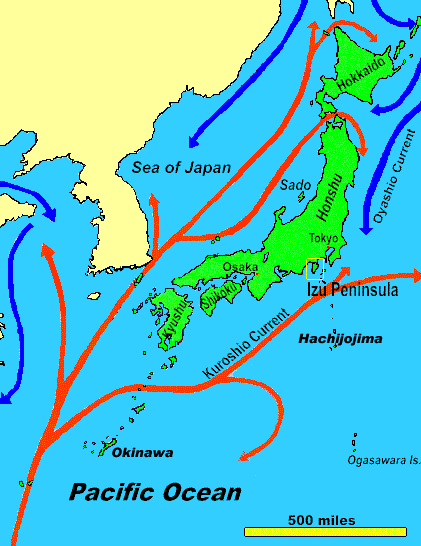Kuroshio Current
THE KUROSHIO IS a warm northeasterly ocean current off the coast of JAPAN. This current is also called the gulf stream of the Pacific or Japan Current. Kuroshio means “the black stream” in Japanese, named after the deep ultramarine color of the high salinity water, which is found flowing north of the current's axis. The system includes the following branches: Kuroshio, up to 35 degrees N; Kuroshio extension, extending eastward into two branches up to 160 degrees E longitude; North Pacific current, a further eastward continuation, which throws branches to the south as far as 150 degrees W; Tsushima current, branches of the main current that run into the Japan Sea, along the west coast of JAPAN; and Kuroshio counter-current, the large swirl or eddy on the east and south east of the Kuroshio.

The Kuroshio originates from the greater part of North Equatorial current, which divides east of the PHILIPPINES. The Kuroshio is the current running from Formosa to about 35 degrees N latitude. It continues directly as a warm current known as the Kuroshio Extension, from there it is continues as the North Pacific current. Water enters the Kuroshio over a broad front, 621 mi (1,000 km) in width, which then accelerates and narrows. A narrow band less than 62 mi (100 km) in width and about .6 mi (1 km) of maximum depth runs for 1,864 mi (3,000 km) along the western edge of the Pacific, between the Philippines and the east coast of Japan. A narrow, intense flow persists for 930 mi to 1,240 mi (1,500 to 2,000 km) after the current leaves Japan's east coast, after which there is a marked drop in velocity. Here, there is no land boundary on the lefthand side to generate a fractional boundary layer.
Kuroshio is a fast ocean current (2 to 4 knots). Every second, the current carries some 50 million tons of sea water past Japan's southeast coast, a flow equal in volume to about 6,000 rivers the size of the DANUBE or the VOLGA. On the whole, there are two distinct types of water in the current: warm, saline water on the right and cold, dilute water on the left The current undergoes marked changes in speed in the location of its axis, which varies from place to place and with seasons. Apart from changes resulting from tides, shortterm changes from a major shift in the axis of the Kuroshio can occur as it flows past southern Japan.
When meanders develop, cold water is brought up toward the surface between the Kuroshio and the coast, and the temperature drops to as much as 50 degrees F (10 degrees C) below normal. This change has a profound effect on coastal and offshore fisheries.
The Kuroshio Current plays a vital role in the circulation of the North PACIFIC OCEAN. The current involves great volumes of water capable of carrying large amounts of heat. The heat, which is carried north by this flow, has an effect on climate of the adjacent land areas. Water temperature offshore strongly influences cloud cover and rainfall. On the southern coast of ALASKA, the effect of the Kuroshio Extension creates a somewhat more temperate climate.